Giving arts a seat at the community development table

In December, the National Endowment for the Arts released a collection of essays titled How to Do Creative Peacemaking: An Action-Oriented Guide to Arts in Community Development. Jason Schupbach, the Director of Design and Creative Placemaking for the National Endowment of the Arts, came to Philly this week to discuss the new book, which he said he thinks of as “a primer on giving arts a seat at the community development table.”
Creative placemaking represents a wide array of work that ranges from public art projects confronting complex social questions to building artist live/work spaces in changing neighborhoods. It can mean development of new cultural institutions or simply using creative expression to foster community engagement.
Schupbach joined a panel*, hosted by Fairmount Park Conservancy, Mural Arts Philadelphia’s muraLAB, and Community Design Collaborative at the Center for Architecture and Design, on Monday night to discuss themes of the book, as well as strategies for creative placemaking in American cities and towns. Lyz Crane, Deputy Director of ArtPlace America, which funds creative placemaking work, and Anne Gadwa Nicodemus, Principal of Metris Consulting, who studies the field and co-authored of the original whitepaper about creative placemaking joined Schupbach to bring a national perspective. Representing Philadelphia’s rich community of creative placemakers were attorney and artist Rasheedah Phillips, founder of the AfroFuturist Affair; Kira Strong, deputy director of design and construction for the city’s Rebuild Initiative; and Aviva Kapust, executive director of the Village of Arts and Humanities in North Philadelphia. (Kapust and Strong both have essays in the new book.) PlanPhilly’s Ashley Hahn moderated the discussion.
ART’S ROLE IN COMMUNITY DEVELOPMENT

The process of creative placemaking aims to evolve space into place through artistic techniques and deep community engagement. “How do we know when we’re in a place?” asked the City of Philadelphia’s Director of Planning and Development, Anne Fadullon, in her opening remarks. “We know it when we feel it.” Sense of place has to do with the attachment felt by a community.
But such an intuitive, simple answer belies the difficulties inherent in the work of creative placemaking. Creative placemaking came about as a response to the 2008 housing crisis, when nonprofits, government agencies, and individuals came together to figure out how the arts could improve communities and help people where they already lived, since most people could not afford to move. Whereas developers typically assume that schools, transportation, and businesses were some of the top reasons people want to live somewhere, Schupbach listed social offerings, openness, and aesthetics as the real reasons people give. He emphasized that adding art to community development work can foster those attributes, and can innovatively address economic development issues too.
Art can be an easier entry point into public discussions about challenges and issues for a wider swath of people. “Art can be fun! It’s a creative approach to conversations that can be hard, that are tired. Art provides a creative gateway and level of engagement from standard civic dialogue,” Strong said. When people partake in these conversations, they have a greater level of control and power and help shape the narrative.
“People are creative every single day to survive,” Kapust said. “When we’re talking about art, we’re talking about creative problem solving too.”
Moreover, art contributes to quality of life and has the ability to help people thrive rather than just survive.
“Art helps people imagine other futures, alternative futures different from the ones they already have,” said Phillips. “That’s a big thing for people who are routinely told that they don’t have possibilities for the future.” She noted that people in unstable situations often deal with worries that prevent them from thinking beyond immediate needs, but art has the ability to take them outside of that.
COMMUNITY COLLABORATION
Panelists emphasized that creative placemaking only works when the community is deeply involved. After all, creative placemaking is about strengthening community and addressing a challenge or issue within that community. Effective creative placemaking, as Hahn pointed out, is not a DIY effort, but DIT (do it together) — in part because the lives of those in the community make up a medium of a project.
“A collaborative practice is critical between the artist, community partner and community itself,” Crane said. “What is the conversation that’s happening? What is the expertise that’s being relied on? There needs to be a sense of reciprocity.”
Anne Gadwa Nicodemus explained that reciprocity and inclusion is necessary to ensure that no one is used and that nothing is done to a community—a project can’t be an imposition. Creative placemaking is about figuring out what’s at stake and who has skin in the game—the artist, developer, and residents of a neighborhood. Reflecting and addressing the needs and wellbeing of those most affected by creative placemaking efforts is a way to avoid projects that contribute to “art washing” or could signal inequitable neighborhood development. Instead, the success of a creative placemaking project is defined for and by the specific community. The best creative placemaking initiatives, according to Schupbach, “deeply engage with the culture of a place and honor people through the work.”
Phillips concurred, noting that those who want to engage in creative placemaking projects in an area must make sure they do their homework: “Go to community meetings, get to know people, get uncomfortable,” she said. “People aren’t going to automatically trust you.”
“When you’re an artist [from outside a community] working in a community, you must become part of the community,” Kapust said, explaining that building equity and empathy should be the goals as much as any resulting physical product. “Establishing shared values early on is really important, and you can’t assume it’s going to be easy.”
CREATIVE PLACEMAKING IN OUR POLITICAL CLIMATE
Without directly addressing the changes at the federal level, Schupbach squashed the notion that the National Endowment for the Arts was in any immediate financial trouble, reminding the audience that, like all federal agencies, the NEA is funded as part of a continuing resolution until April 28th. (Fiscal Year 2018 will be Trump’s first budget, and anyway, “Congress controls the purse strings,” he said.)
Creative placemaking efforts can bloom even without a robust budget—scrappy Philly, which Schupbach called “one of the best creative placemaking sites in the country,” is no stranger to that.
“[In Philly,] there’s a culture where not everything is at your fingertips,” Strong said. The drive to figure out how to solve a problem or how to make an idea into a reality leads to partnerships and sharing resources—key ingredients when it comes to forging alliances and building solidarity among neighbors.
Creative placemaking, like political work, “is incredibly complex, and because it’s complex, it’s messy, it’s chaotic, it’s human scale,” Kapust said.
These days, stronger communities and more collaborative processes are more important than ever—but panelists maintained that the aims of creative placemaking haven’t shifted.
“What’s going on in the places that need this the most has been going on for a long time,” Kapust said. Crane, too, said creative placemaking’s focus on community and self-determination to be just as important as ever.
Gadwa Nicodemus, however, argued that, “ some issues we’re coping with have a greater sense of urgency than techniques of creative placemaking may be suited for.” While creative placemaking can be iterative, incremental work, she asked, “How can creative placemaking transition and be repurposed to meet the pressing needs of a civil society?”
*Disclosure: PlanPhilly was a media partner for this event and the discussion was moderated by editor Ashley Hahn.
WHYY is your source for fact-based, in-depth journalism and information. As a nonprofit organization, we rely on financial support from readers like you. Please give today.





